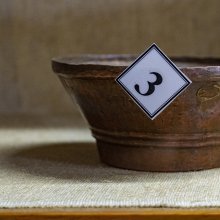Scale: 3 definitions
Introduction:
Scale means something in Hinduism, Sanskrit. If you want to know the exact meaning, history, etymology or English translation of this term then check out the descriptions on this page. Add your comment or reference to a book if you want to contribute to this summary article.
Images (photo gallery)
(+7 more images available)
In Hinduism
Gitashastra (science of music)
Source: Shodhganga: Elements of Art and Architecture in the Trtiyakhanda of the Visnudharmottarapurana (gita)The Scale of seven notes (in Indian Music) is denoted by the Sanskrit word saptaka (lit. “the scale of seven notes”).—According to the Viṣṇudharmottarapurāṇa, three kinds of scales or octaves viz., mandra i.e., low pitch, madhya i.e., medium pitch and tāra i.e., high pitch are there in Music and these three kinds of octaves occur from the three respective sthānas viz., chest, throat and head.
Gitashastra (गीतशास्त्र, gītaśāstra) refers to the ancient Indian science of Music (gita or samgita), which is traditionally divided in Vocal music, Instrumental music and Dance (under the jurisdiction of music). The different elements and technical terms are explained in a wide range of (often Sanskrit) literature.
Shilpashastra (iconography)
Source: Shodhganga: Elements of Art and Architecture in the Trtiyakhanda of the Visnudharmottarapurana (shilpa)The Scales of Fish are denoted by the Sanskrit term Śakala, and represents one of the various substances used in the process of creating a Canvas, in the ancient Indian art of Painting (citra), according to the Viṣṇudharmottarapurāṇa, an ancient Sanskrit text which (being encyclopedic in nature) deals with a variety of cultural topics such as arts, architecture, music, grammar and astronomy.—In the Mānasollāsa also, lime is prescribed to make a canvas. The mixture, thus prepared for canvas is mixed with vālukā i.e., sand and it should be soaked in water having śakala i.e., the scales of a fish and then the mixture should be kept aside for a month for drying. When the paste is completely dried up, it will be ready for use as plaster and the painters can apply this on a wall according to their necessity.

Shilpashastra (शिल्पशास्त्र, śilpaśāstra) represents the ancient Indian science (shastra) of creative arts (shilpa) such as sculpture, iconography and painting. Closely related to Vastushastra (architecture), they often share the same literature.
Yoga (school of philosophy)
Source: ORA: Amanaska (king of all yogas): A Critical Edition and Annotated Translation by Jason BirchThe Scales (of weight) is denoted by the Sanskrit term Tulā, according to the Amanaska Yoga treatise dealing with meditation, absorption, yogic powers and liberation.—Accordingly, as Īśvara says to Vāmadeva: “[...] Just as the weigher holds the unstable scales (tulā) steady, so, the [unstable] activities of [the Yogin’s] mind [are held steady] in the self, when [transcendental] happiness has arisen through his constant practice. [...]”.

Yoga is originally considered a branch of Hindu philosophy (astika), but both ancient and modern Yoga combine the physical, mental and spiritual. Yoga teaches various physical techniques also known as āsanas (postures), used for various purposes (eg., meditation, contemplation, relaxation).
See also (Relevant definitions)
Ends with: All-scale, Fish scale, Lens scale, Nishcale, Shad-scale, Silverscale, Slender wedgescale, Wingscale.
Full-text (+843): Grama, Shalka, Valkavat, Taraju, Gramavishesha, Svara, Dhata, Valka, Tula, Gramaraga, Murchana, Mapana, Khavalya, Tajava, Paradem, Shakala, Naraci, Kutatula, Shakalin, Shalkin.
Relevant text
Search found 230 books and stories containing Scale; (plurals include: Scales). You can also click to the full overview containing English textual excerpts. Below are direct links for the most relevant articles:
The Brahmanda Purana (by G.V. Tagare)
Notes on Grāmas, Mūrcchanās and Tānas < [Notes]
Chapter 61 - A dissertation on Music < [Section 3 - Upodghāta-pāda]
Chapter 67 - The origin of Dhanvantari < [Section 3 - Upodghāta-pāda]
Rasa Jala Nidhi, vol 3: Metals, Gems and other substances (by Bhudeb Mookerjee)
Part 8 - Semi-poison (8): Jayapala (croton seeds) < [Chapter XXXI - Upavisha (semi-poisons)]
Part 2 - Alkaline substance (2): Usara or Sora (salt-petre) < [Chapter XXVIII - Kshara (akalis)]
Amaravati Art in the Context of Andhra Archaeology (by Sreyashi Ray chowdhuri)
Sarvaṃdadavadāna (Sibi Jātaka) < [Chapter 3 - Amarāvatī and the Formative Stage of the Buddhist Art]
Religious background of early Andhra Pradesh < [Chapter 3 - Amarāvatī and the Formative Stage of the Buddhist Art]
Epigraphs from Amarāvatī (i) Monks and Nuns < [Chapter 4 - Survival of Amarāvatī in the Context of Andhra Art]
Some Aspects Of Hindu Music < [January-February 1931]
Oriental Music < [April 1969]
Time Measurements over the Centuries < [April – June, 1994]
Manusmriti with the Commentary of Medhatithi (by Ganganatha Jha)
Verse 8.321 < [Section XLIII - Theft (steya)]
Verse 5.15 < [Section II - Objectionable Food]
Verse 8.403 < [Section XLVIII - Laws relating to Civic Misdemeanours]
Vishnudharmottara Purana (Art and Architecture) (by Bhagyashree Sarma)
3. Vocal Music (Gīta) < [Chapter 2 - Music]
5. Preparation of Canvas before Painting < [Chapter 5 - Painting and Image Making]
2. The Importance of the Term Citra < [Chapter 5 - Painting and Image Making]
Related products









